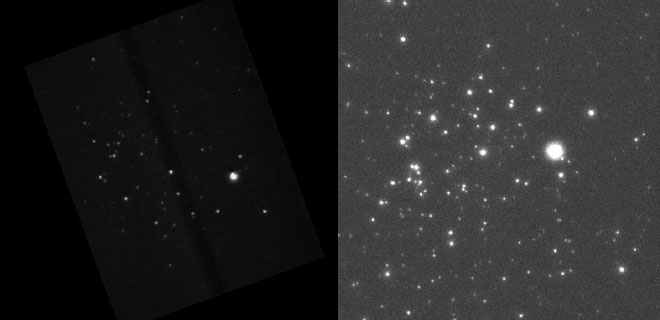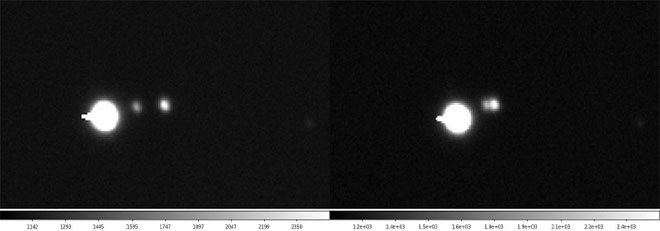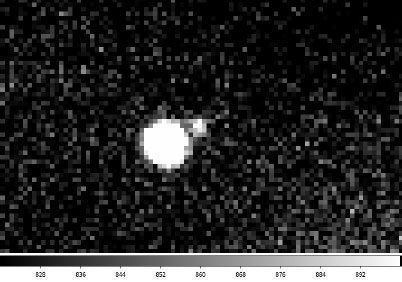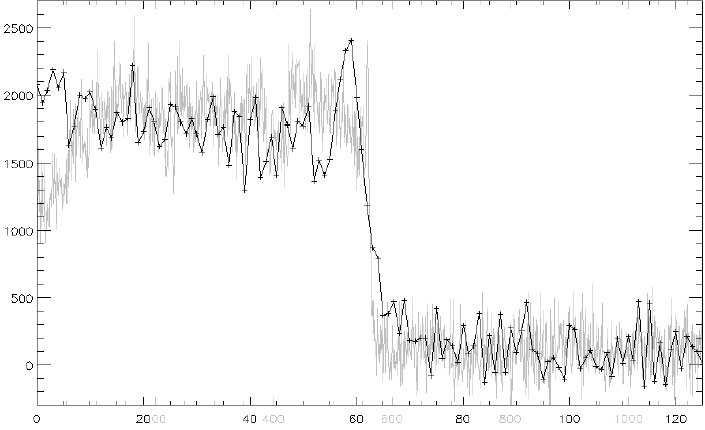Resources
 Part of the Oxford Instruments Group
Part of the Oxford Instruments Group
Expand
Collapse
 Part of the Oxford Instruments Group
Part of the Oxford Instruments Group
The Alfred-Jensch telescope (AJT) is a versatile telescope which can either be used for wide-field imaging in the Schmidt mode, or for the high-resolution Echelle spectrograph in the Coudé mode. In the Schmidt mode the AJT has an aperture of 1.34m, and 2m in the Coudé. A CCD camera with 6144 x6160 pixels of 15 μm is being used for wide-field imaging. The image scale is 0.77 arcsec per pixel and the field-of view 1.7 square degrees. A high-resolution Echelle spectrograph is located at the Coudé-focus which has a two-pixel resolution of R=67000.
Both modes require accurate guiding. For the Schmidt mode guiding is provided by a classical Fraunhofer refractor with an aperture of 30cm and a focal length of 475cm. At the Coudé-focus a camera guiding is provided by a camera that looks at the entrance slit of the spectrograph. Up to now, both modes use a TV-guiding system with image intensifiers. However, this system has a number of drawbacks.
The most severe one is its sensitivity, or rather the lack of it. Quite often the guide stars are not bright enough to correct the telescope position with a frequency of 10 seconds or less but only at a rate of 25 to 50 seconds. Unfortunately, this rate is too low to provide accurate tracking. This lack of accurate guiding not only makes the telescope less efficient, it also reduces the accuracy of radial-velocity measurements in the spectroscopic mode. The reason is that bad tracking causes a shift of the spectral lines during the exposure. Although we use an iodine cell and which allows us to measure this shift, the accuracy of radial-velocity measurements is still reduced. This is because we aim to achieve a radial-velocity accuracy of 3 m/s, which corresponds to 0.0013 pixel on the detector of the spectrograph. Thus, even a tiny smearing of the spectral lines reduce the accuracy.
The second disadvantage of the original system is its non-linearity which makes it impossible to determine the brightness of the stars while taking spectra of them. Simultaneous spectroscopic and photometric observations are, however, needed to study flare-eruptions on stars. Studying such events is important because they can have severe effects on the habitability of planets.
Given all these limitations of the old system, we started looking for a new camera system. After extensive tests, we finally selected the iXon Ultra 888 EMCCD detectors with 1024x1024 pixels of 13 μm for the guide telescope, as well as for the Coudé focus. The image scale of this camera is 0.56 arcsec per pixel and the fieldof- view 9.6x9.6 arcmin with the guide telescope. This type of cameras has several advantages: The most important one is that it is very sensitive, allowing us to take low-noise images at a high rate. Because the telescope has two guide telescopes of 30 cm aperture, we could compare the old and the new system directly. Fig.1 shows the star-cluster M52 simultaneously observed with the old and the new system. The gain in sensitivity of the new system is dramatic. Thanks to the new camera, the tracking is now much better than before which makes the telescope more powerful. The second advantage of the new system is that it is linear. It is now possible to measure the brightness of the stars while taking spectra of them.

Fig.1 Star cluster Messier 52 observed with the old system (left) and with the iXon Ultra 888 EMCCD (right).
Originally, we acquired the iXon Ultra as guiding cameras to autoguide the 2-m Alfred Jentsch telescope. It had not been planned to use them as a science instrument in the prime focus of the Schmidt telescope. However, the new EMCCD also opens up new observing possibilities for observations with the main telescope. Examples are the stellar occultations like those of Neptune's moon Triton and lunar occultation of stars which we describe in the following.
In August 2017 we were approached by a team from SOFIA - the Stratospheric Observatory For Infrared Astronomy, operated jointly by NASA and Deutsches Zentrum für Luft- und Raumfahrt - to participate in a measuring campaign of an occultation of the star UCAC4 410-143659 by Neptune's moon Triton on the night of October 5./6. 2017. The SOFIA team had been using an earlier iXon Ultra model for some time.
Therefore, the iXon Ultra was installed in the prime focus of the telescope for the first time. Since it was not possible to keep the control computer near the camera within the telescope, we were faced with the problem of a very long connecting cable of up to 50m, not possible with USB3. To bridge this long distance, we used a fibre-optic light guide, keeping the USB3 cables on both sides at 0.5m. The fibre couplers Spectra 3022 REX and Spectra 3022 LEX worked very reliably in this set-up.
Since the main scientific goal of this multi-site measurement campaign was to determine structural changes in Triton's atmosphere, it was of utmost importance for every participating observer to have exact time stamps for every frame of the highspeed photometric imaging. Like for the SOFIA team, this time signal was provided by a GPS receiver TM-4 of Spectrum Instruments (Canada) for us. We used the trigger option of the iXon Ultra to trigger time stamping with the TM-4. These time stamps were written to a log file, and later in data reduction matched to the iXon Ultra frames. It turned out that this procedure worked flawlessly, and not a single frame or trigger was lost out of about 50000.
The panels below are displaying images at various phases of the occultation event. Fig. 2 is showing Neptune as the bright source on the left, its moon Triton in the middle, and the to be occulted star on the right. In the second panel, Neptune and Triton have approached the star closely, because of their orbital motion around the Sun, and the occultation is immanent. Fig.3 is displaying the middle of the occultation event: fainter Triton is dimming the brighter star now. A scientific publication of this observation is in preparation.

Fig. 2: Two images from the observing campaign to observe the occultation of a star by Neptune's moon Triton. Seen from left to right are Neptune, Triton and the star UCAC4 410-143659.

Fig. 3: The middle of the event. Triton is occulting the star.
The, so far unique, chance of having a high-speed photometric camera in the prime focus of the 2-m Alfred Jentsch telescope was also used for the recording of an occultation of a star by our Moon. The limb of the Moon here is used as a sharp edge that is creating a Fresnel diffraction pattern. Since the limb is moving, that diffraction pattern is moving across the observer, who can sample it with a high-speed photometer and derive the size of the occulted object from it. This observing technique yields one-dimensional angular resolution in the milli-arcsecond range, which allows us to separate close binaries and derive stellar diameters.
In order to reach the required very high frame rates, we used windowing of the detector. A small window is sufficient, since only the to-be-occulted star needs to be observed. This way, we reach a frame rate of about 230 frames per second. Such a fast readout apparently is demanding for the Peltier cooler of the iXon Ultra.
Fig. 4 is showing the photometric light-curve of the lunar occultation of the star SAO164434. In light grey the whole dataset is shown, whereas the black curve is a zoom in into that light grey light-curve by a factor of ten around the moment of occultation, to make the measurable Fresnel pattern better visible. While this was only a test to demonstrate the feasibility of such measurements with our iXon Ultra and the instrumental setup, it showed very successfully that lunar occultation measurements at scientific quality are possible.

Fig. 4: Light-curve of the lunar occultation of the star SAO164434.
Date: February 2020
Author: Dr Eike Guenther, TLS Tautenburg, Germany
Category: Application Note
